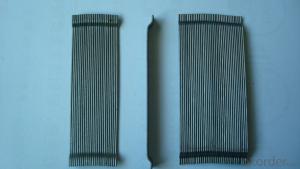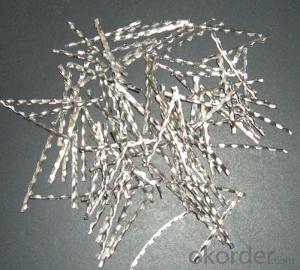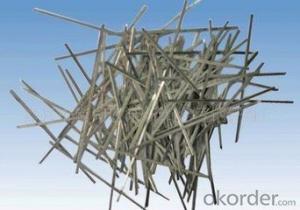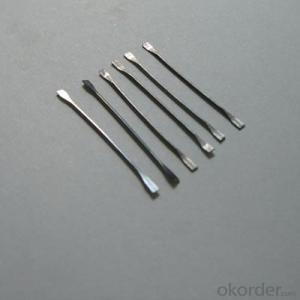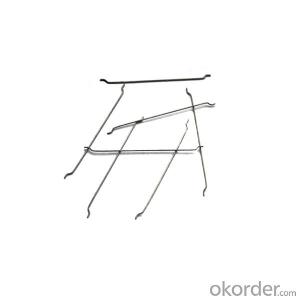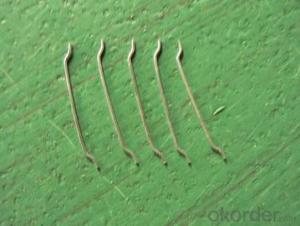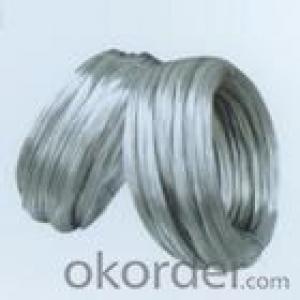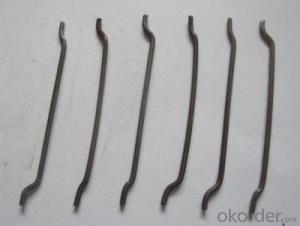Steel Fiber Wavy for Construction and Concrete for Concrete Reinforcement
- Loading Port:
- Tianjin
- Payment Terms:
- TT OR LC
- Min Order Qty:
- 5 kg
- Supply Capability:
- 250000 kg/month
OKorder Service Pledge
OKorder Financial Service
You Might Also Like
Quick Details
material: steel wire
shape: corrugated round fiber
appearance: clean and bright
usage: construction and concrete
Place of Origin: Shandong, China (Mainland)
Model Number: steel fiber
Product features
steel iber for concrete reinforcement ,it`s widely used in buildings ,bridges ,thin roof engineering ,highway etc
1.high tensile strength 1000 to 2850 Mpa
2.diameter 0.12 to 1.0mm
3.length 6 to 60mm
Specifications
Specification D/L | Diameter-D (mm) | Length-L (mm) | Aspect ratio (L/D) | Tensile strength (Mpa) |
0.12/6 | 0.12 | 6 | 50 | 2850 |
0.2/6 | 0.2 | 6 | 30 | 2850 |
0.2/13 | 0.2 | 13 | 65 | 2850 |
0.3/25 | 0.3 | 25 | 83 | 2850 |
0.4/25 | 0.4 | 25 | 63 | 1200 |
0.4/30 | 0.4 | 30 | 75 | 1200 |
0.5/30 | 0.5 | 30 | 60 | 1100 |
0.5/25 | 0.5 | 25 | 50 | 1100 |
0.55/25 | 0.55 | 25 | 45 | 1100 |
0.6/30 | 0.6 | 30 | 50 | 1100 |
0.7/30 | 0.7 | 30 | 43 | 1100 |
0.7/35 | 0.7 | 35 | 50 | 1100 |
0.75/35 | 0.75 | 35 | 47 | 1100 |
0.75/60 | 0.75 | 60 | 80 | 1100 |
0.8/60 | 0.8 | 60 | 75 | 1000 |
0.9/50 | 0.9 | 50 | 56 | 1000 |
0.9/60 | 0.9 | 60 | 67 | 1000 |
1.0/50 | 1.0 | 50 | 50 | 1000 |
1.0/60 | 1.0 | 60 | 60 | 1000 |
Picture
HOOKED END STEEL FIBER
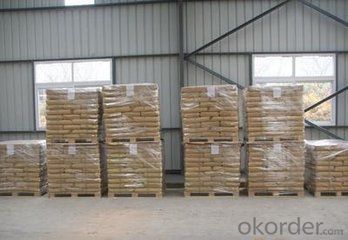
WAVY STEEL FIBER

SHEARING STEEL FIBER
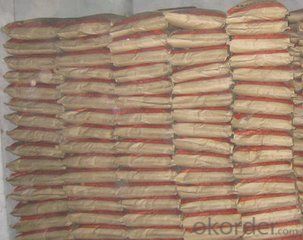
FAQ
we can produce any type steel fiber and of course we can make production according to your requirement
steel fiber for concrete reinforcement from 1100 to 2850 mpa
- Q:Can melt extract stainless steel fiber be used in highway pavements?
- Yes, melt extract stainless steel fiber can be used in highway pavements. It is commonly used as a reinforcement material in concrete to improve its strength and durability, making it suitable for high traffic areas such as highways. Stainless steel fibers offer excellent resistance to corrosion and can enhance the overall performance and lifespan of highway pavements.
- Q:How does melt extract stainless steel fiber improve the resistance to seismic loading in concrete?
- Melt extract stainless steel fiber is a type of reinforcement material that can significantly enhance the resistance to seismic loading in concrete structures. Seismic loading refers to the stress and vibrations experienced by buildings during earthquakes or other seismic events. One of the key mechanisms through which melt extract stainless steel fiber improves seismic resistance in concrete is by enhancing its tensile strength and ductility. Stainless steel fibers are incredibly strong and are capable of withstanding high levels of stress and strain. When added to concrete, these fibers act as a reinforcement, bridging the cracks that occur under seismic loading and preventing them from propagating further. Moreover, melt extract stainless steel fiber also improves the bond between concrete and other construction materials, such as reinforcing bars or steel frames. This increased bond strength helps to distribute the seismic forces more evenly throughout the structure, reducing localized stress concentrations and improving overall stability. Another significant advantage of using melt extract stainless steel fiber in concrete is its ability to absorb and dissipate energy during seismic events. When the ground shakes, the fibers absorb the energy generated by the seismic forces, preventing it from being transferred to the concrete matrix. This energy absorption capability helps to reduce the overall stress on the concrete and enhances its ability to withstand seismic loading. Additionally, melt extract stainless steel fiber can also improve the durability and longevity of concrete structures in seismic regions. The fibers act as a barrier against corrosion and deterioration, preventing the ingress of moisture and harmful chemicals that may weaken the concrete over time. This enhanced durability ensures that the structure remains resilient and can withstand multiple seismic events throughout its lifespan. In summary, melt extract stainless steel fiber improves the resistance to seismic loading in concrete by enhancing its tensile strength, ductility, bond strength, and energy absorption capacity. By mitigating the propagation of cracks, distributing seismic forces more evenly, and increasing the overall durability, this reinforcement material significantly improves the seismic resistance of concrete structures, making them more resilient and safer in earthquake-prone areas.
- Q:What is the mechanism of steel fiber spacing enhancement?
- Through the analysis of composite theory and steel fiber spacing theory, it is proved that stainless steel fiber has the potential of higher resistance to cracking, and its tensile strength is improved remarkably,
- Q:What is the effect of melt extract stainless steel fiber on the fatigue resistance of concrete?
- Concrete's fatigue resistance can be greatly improved by adding melt extract stainless steel fiber. These fibers, which are known for their strength and durability, are well-suited for enhancing the performance of concrete in applications where fatigue is a concern. The main benefit of melt extract stainless steel fiber in terms of concrete's fatigue resistance is its ability to reinforce the material. These fibers form a distributed network within the concrete, effectively connecting any cracks that may occur during repeated loading. By preventing crack propagation and reducing their width, the presence of stainless steel fibers enhances the overall fatigue strength of the concrete. Moreover, the high ductility and corrosion resistance of stainless steel fibers also contribute to the improved fatigue resistance of concrete. These fibers have the capability to absorb and distribute stress energy, thereby reducing stress concentration in specific areas. This energy dissipation ability helps to prevent the formation and growth of cracks, ultimately enhancing the fatigue performance of the concrete. Furthermore, the addition of melt extract stainless steel fiber can enhance the toughness and durability of concrete as a whole. These fibers increase the resistance of the material to impact and dynamic loading, making it more resistant to fatigue failure. This is particularly advantageous in structures that experience repetitive loading, such as bridges, pavements, and industrial floors. In conclusion, the incorporation of melt extract stainless steel fiber significantly enhances the fatigue resistance of concrete. The reinforcement provided by these fibers, along with their high ductility and corrosion resistance, improves crack bridging, reduces crack width, and enhances the overall toughness of the material. As a result, structures reinforced with stainless steel fibers exhibit improved durability and longer service life, making them well-suited for applications where fatigue is a concern.
- Q:Can melt extract stainless steel fiber be used in architectural facades or cladding systems?
- Yes, melt extract stainless steel fiber can be used in architectural facades or cladding systems. It offers excellent strength and durability, making it suitable for enhancing the structural integrity and aesthetics of buildings. Additionally, its resistance to corrosion and weathering makes it an ideal choice for long-lasting architectural applications.
- Q:How does melt extract stainless steel fiber improve the resistance to chemical attack in concrete?
- Melt extract stainless steel fiber is known for enhancing the resistance to chemical attack in concrete due to its unique properties and characteristics. When added to concrete mixtures, the stainless steel fibers act as a reinforcement that improves the durability and longevity of the concrete structure. One of the primary ways in which melt extract stainless steel fiber improves the resistance to chemical attack is by forming a physical barrier against corrosive substances. Concrete is generally susceptible to chemical attack from substances such as acids, alkalis, and chlorides, which can penetrate the concrete matrix and cause deterioration over time. However, the addition of stainless steel fibers creates a network of reinforcement within the concrete, which acts as a protective barrier against chemical intrusion. This, in turn, reduces the permeability of the concrete and prevents the corrosive substances from reaching and damaging the underlying steel reinforcement. Furthermore, melt extract stainless steel fiber also enhances the resistance to chemical attack by improving the mechanical properties of the concrete. The addition of stainless steel fibers increases the flexural strength, tensile strength, and impact resistance of the concrete, making it more resistant to cracking and spalling caused by chemical exposure. This improved mechanical performance helps to maintain the integrity of the concrete structure and prevents the ingress of corrosive substances through cracks and fissures. Moreover, stainless steel fibers also play a crucial role in minimizing the effects of chemical attack by reducing the formation of microcracks in the concrete. Chemical attack can lead to the formation of cracks and fractures in the concrete, which can further accelerate the deterioration process. However, the presence of stainless steel fibers helps to distribute the stress and load more evenly throughout the concrete, preventing the concentration of forces that can lead to crack formation. By minimizing the formation of microcracks, the stainless steel fibers effectively reduce the vulnerability of the concrete to chemical attack and enhance its overall durability. In conclusion, melt extract stainless steel fiber improves the resistance to chemical attack in concrete by forming a physical barrier against corrosive substances, enhancing the mechanical properties of the concrete, and minimizing the formation of microcracks. These combined effects result in a more durable and long-lasting concrete structure that is better able to withstand the detrimental effects of chemical exposure.
- Q:What is the effect of melt extract stainless steel fiber on the flexural strength of concrete?
- The melt extract stainless steel fiber improves the flexural strength of concrete by enhancing its tensile and flexural properties. The addition of these fibers helps to control cracking and increase the overall durability and toughness of the concrete, making it more resistant to bending and flexing forces.
- Q:What is the effect of melt extract stainless steel fiber on the shrinkage and cracking of concrete?
- The effect of melt extract stainless steel fiber on the shrinkage and cracking of concrete is primarily related to its ability to improve the overall tensile and flexural strength of the concrete matrix. When added to concrete, melt extract stainless steel fibers act as reinforcement, reducing the occurrence of shrinkage and cracking. Shrinkage in concrete occurs due to the drying process, causing the concrete to contract and potentially lead to cracks. By adding melt extract stainless steel fibers to the mix, the concrete's tensile strength is enhanced, reducing the likelihood of shrinkage cracks. The fibers act as a network within the concrete, distributing the forces and stresses more evenly, thereby mitigating the potential for shrinkage-related cracking. Additionally, melt extract stainless steel fibers can improve the resistance of concrete to cracking caused by external factors such as temperature changes, heavy loads, or structural movements. These fibers help to reinforce the concrete, increasing its ability to withstand bending and tensile forces, which can ultimately minimize the occurrence of cracking. Moreover, melt extract stainless steel fibers also improve the durability and longevity of concrete structures. By reducing shrinkage and cracking, the fibers contribute to the overall integrity and stability of the concrete, ensuring it can withstand various environmental and load conditions over an extended period. In summary, the addition of melt extract stainless steel fiber to concrete positively affects shrinkage and cracking by enhancing the concrete's tensile strength, reducing the occurrence of shrinkage-related cracks, and improving its resistance to external forces. Ultimately, this results in more durable and long-lasting concrete structures.
- Q:Can melt extract stainless steel fiber be used in swimming pool structures?
- Yes, melt extract stainless steel fiber can be used in swimming pool structures. Stainless steel fibers are known for their high strength, durability, and corrosion resistance, making them suitable for various applications, including swimming pool structures. These fibers can be added to the concrete mix used for constructing pool walls, floors, and other components to enhance their overall strength and durability. The stainless steel fibers also help to prevent cracking and increase the resistance to water and chemical damage, which is especially important in a swimming pool environment. Additionally, the use of stainless steel fibers can improve the overall lifespan and performance of the pool structure by minimizing maintenance and repair needs.
- Q:Does melt extract stainless steel fiber improve the resistance to carbonation in concrete?
- Yes, melt extract stainless steel fiber can improve the resistance to carbonation in concrete.
1. Manufacturer Overview |
|
|---|---|
| Location | |
| Year Established | |
| Annual Output Value | |
| Main Markets | |
| Company Certifications | |
2. Manufacturer Certificates |
|
|---|---|
| a) Certification Name | |
| Range | |
| Reference | |
| Validity Period | |
3. Manufacturer Capability |
|
|---|---|
| a)Trade Capacity | |
| Nearest Port | |
| Export Percentage | |
| No.of Employees in Trade Department | |
| Language Spoken: | |
| b)Factory Information | |
| Factory Size: | |
| No. of Production Lines | |
| Contract Manufacturing | |
| Product Price Range | |
Send your message to us
Steel Fiber Wavy for Construction and Concrete for Concrete Reinforcement
- Loading Port:
- Tianjin
- Payment Terms:
- TT OR LC
- Min Order Qty:
- 5 kg
- Supply Capability:
- 250000 kg/month
OKorder Service Pledge
OKorder Financial Service
Similar products
New products
Hot products
Related keywords
